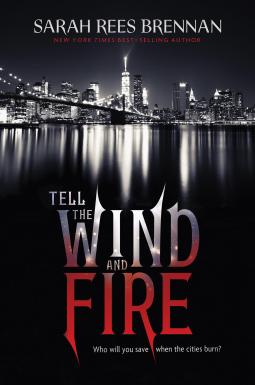
Sarah Rees Brennan
Houghton Mifflin Harcourt Children’s

Amazon | Barnes & Noble | Goodreads
In this future New York, the city is divided in two: Light vs Dark. Only Light Magicians can live in and access the wealthy, upper-class life. The Dark Magicians are banished to the Dark, to carve out lives in poverty under harsh rule imposed by the Light leadership.
Lucie and her father escaped the dark at a high price. Now Lucie survives at the mercy of friends and by burying her past as deeply as she can. Only, the people in the Dark don’t want her to forget. They’ve made her name a rallying cry to a revolution that could destroy the new life Lucie has fought so hard to create and the boy she loves more than anything.
This is the first time I’d ever read anything by Sarah Rees Brennan, so I was really excited to give this one a go. The first page totally hooked me. I was like oh boy. Must know more.
Then… somewhere in the rest of the first chapter, I got really lost. There was some explanation of the Light vs Dark storyworld and I don’t know if it was just me, but I really had a hard time following it. I reread it once and ended up kind of just moving on. Something about a magical caste system. Okay.
Once I got past that, I was still pretty intrigued. I worried about Ethan being boring, as other reviewers have claimed. (What is it with modern novels about strong women featuring these eye-candy-only men? Didn’t we argue that this was a bad idea when the gender roles of these characters were reversed?) Honestly, my first impression of him was that he was kind of a doofus with money. A cute doofus with money, but yeah, not much else really going on upstairs behind the dreamboat eyes, you know?
However. Without giving anything away, I just want to say there were some unanticipated hidden depths. And I found myself a little disappointed because I kind of wanted Carwyn to have this reformation going on that flew in the face of what everyone thought about his kind. I thought he and Lucie made a great team, so I started rooting for him, and then Ethan manned up and I was like, wait… now I like them both!
I read this book not knowing it was a retelling of a classic, (though I found myself thinking hey, this is kind of like that one book, as I was reading) so I don’t want to give that away for anyone who wants the same experience. I liked reading it not knowing where it was going.
I’d definitely read more of this series because I loved the characters and have a lot of faith in Brennan’s ability to get me to invest in them. The storyworld was confusing to me and I kind of just decided to overlook it. The Light vs Dark stuff really didn’t play a huge role in the story other than establishing two opposing sides in which one has huge advantages and oppresses the other side.
If you liked Across the Star-swept Sea by Diana Peterfreund, give this one a read. See below for any content information.
None.
Romance/Sexual Content
While there’s no explicit description of sex, it’s implied that Ethan and Lucie are intimate with each other. Lucie mentions that she only sleeps well when she sleeps with Ethan, that sort of thing. Another character makes a brief comment about his preference for “deviant sex acts” (he doesn’t specify anything further than that.) There are a few kisses.
Spiritual Content
The city is divided into sectors of Light and Dark magic. Not everyone has magical ability. Dark Magicians have been threatening to revolt and overthrow the Light Magicians in power. Lucie knows a powerful way Light and Dark magic can be used together.
Violent Content
Lawbreakers endure harsh punishments and torture (only described very briefly.) Revolutionaries attack without mercy in a battle scene, killing even innocent bystanders.
Drug Content
Lucie takes Carwyn to a club and offers to buy him a drink. A friend offers to get them some dust, a kind of illegal drug, but Lucie wanted no part of that.
Note: I received a free copy of this book in exchange for my honest review.
Save